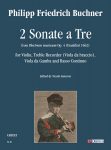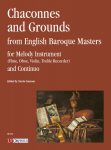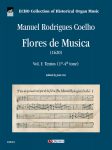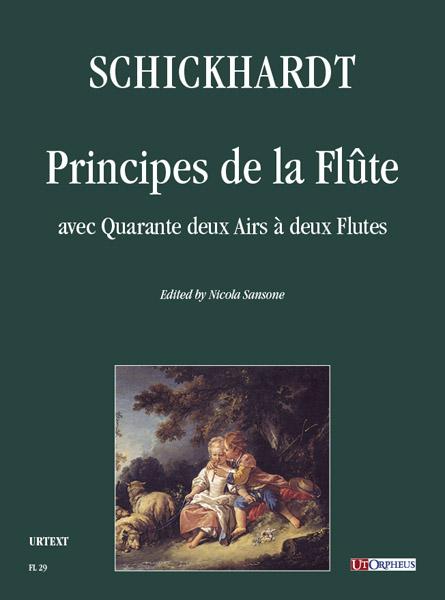Schickhardt: Principes de la Flûte avec Quarante deux Airs à deux Flutes
Edited by Nicola Sansone
vi + 43pp.
FL29 ISMN 979-0-2153-2555-5
£18.95 (UK retail; from website €16.95 + P&P)
After what must be the briefest introduction to notation ever (Schickhardt’s four tables with explanations in French and Flemish), and a fingering chart including trills, it is straight into the music. The first piece is all of six bars and played in unison; the second is shorter but has more notes and tonguing indications, then the third is already conceived in two voices, introduces binary form and only has tonguing marks for certain parts, then the remaining 39 pieces work their way through a variety of keys and dance styles as well as occasional through-composed movements. While the upper voice might “take the lead” more, it certainly does not hog the limelight; the composer is very careful to involve both players in a thoroughly musical dialogue. None of the pieces is longer than two pages, and the majority are far shorter, so these are study rather than recital pieces. That said, I can definitely see a market for this nicely printed volume.

Buchner: 2 Sonate a Tre from Plectrum musicum Op. 4 (Frankfurt 1662)
Edited by Nicola Sansone
iv + 16pp.
FL30 – ISMN 979-0-2153-2556-2
£21.95 (UK retail; from website €19.95 + P&P)
Ostensibly published as a set of sonatas for strings, the “Viola da braccio” part-book for these two sonatas (nos. 10 & 11 in the set) give the scoring as “Flautto vel Viola da braccio”, so the editor is correct to publish them as recorder music but sadly a little hopeful in describing the piece on the cover as “Treble Recorder in G” – unless, of course, that is a misunderstanding of the English usage of Treble in this context to refer to Alto. Printed originally in the soprano clef (middle C on the bottom line), the opening phrase of Sonata X extends to E which is below the instrument’s standard range. But worse is to come – just in case someone was screaming at the screen about fudging that note – as bar 67 has a D, and then bar 78 has a C. Sonata XI has the same range, so there is little doubt that the music is actually far better suited to a Tenor Recorder. Were I to have edited this piece for publication, I would have ignored that fact that there is a separate bass part, since it is identical to the continuo line; rather than fifteen staves per page with the (also identical) figured bass squeezed into the available space, the layout would be much more comfortable. The music is well worth playing, and groups programming – for example – sonatas and concertos by Telemann for the same line-up should not hesitate to deploy these as variety.

Chaconnes and Grounds from English Baroque Masters
Edited by Nicola Sansone
v + 30pp.
HS253 – ISMN 979-0-2153-2542-5
£23.50 (UK retail; from website €20.95 + P&P)
The eight pieces in this very useful volume are by Thomas Williams and Gottfried Keller (one ground each) and Gottfried Finger (three grounds and three chaconnes), all of them taken from four volumes printed in Amsterdam at the beginning of the 18th century. The range of the solo part suites the treble (=alto) recorder perfectly and the music here is far more demanding than in the Schickhardt collection above. Violinists should not be put off, though, as there is much elegant music here which will help younger players in particular to find ways to differentiate between each iteration of the theme above which they must weave their filigree. Ut orpheus has already published the source books (FL2, FL6, FL11 and FL17), should you fancy playing more of the repertoire than variations on a bass!

Manuel Rodrigues Coelho: Flores de Musica (1620) Vol. I: Tentos (1st-4th tone)
ECHO Collection of Historical Organ Music [volume 3]
Edited by João Vaz
xxvi + 128pp.
ECHOM3 – ISMN 979-0-2153-2606-4
£56.50 (UK retail; from website €50.95 + P&P)
I am by no stretch of the imagination a keyboard player. That said, in order to develop something akin to a reasonable technique, I remember shutting myself away in a practice room at university and devoting hours to playing Andrea Gabrieli’s organ music; it had the perfect blend (from my perspective, at least!) of sustained chords and moving parts, limited harmonic movement and few – if any – demanding leaps (especially in the left hand). That is also how I would described the contents of this excellent volume which contains 12 Tentos (three in each of the four modes). The original (as shown in the facsimiles dotted throughout the book) was printed on four staves; in compressing them on to two, the editor has (to my mind) sometimes been a little too pedantic (why print a superfluous bar’s rest when there are two other parts vying for the space on the staff at the time?) and not pedantic enough at others (where a note is inflected in one voice but not in the other, if the second accidental is not in the original, should it not be bracketed as an editorial insertion?) One small quirk of the printing is the notation of triplets; instead of the standard chunky 3 over the middle of the figure, this volume prints small 3s over the first note of each group which, in keyboard music, made me think they were fingering instructions. These are, however, minor faults in such an excellent volume. If I had access to an organ (or even a piano!), I think I might be tempted to sit down and play these pieces!
Brian Clark
